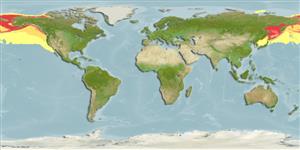Common names from other countries
Environment: milieu / climate zone / depth range / distribution range
Ecologie
Bathydemersaal. Subtropical; 90°N - 0°S, 126°E - 115°W
Pacific Ocean and the Arctic: Eastern side of Ostrov Sakhalin to northern Hokkaido. Subtropical to polar.
Length at first maturity / Size / Gewicht / Leeftijd
Maturity: Lm ? range ? - ? cm Max length : 170 cm TL mannelijk/geslacht niet bekend; (Ref. 1394); 160 cm TL (female); Maximaal gepubliceerd gewicht: 123.0 kg (Ref. 1394)
Inhabit the southern edges of the pack ice from winter to early summer and coastal areas including river mouths, in late summer and autumn. Diet composition varies with the age of the seal; Newly weaned pups feed on small crustaceans, advance to schooling fishes, larger crustaceans, and octopuses, and finally graduate to bottom dwelling fish and cephalopods (Ref. 1394).
Jefferson, T.A., S. Leatherwood and M.A. Webber. 1993. (Ref. 1394)
Status op de Rode Lijst van het IUCN (Ref. 130435: Version 2024-1)
Status bij CITES (Ref. 108899)
Not Evaluated
Not Evaluated
Gebruik door de mens
Visserij: commercieel
FAO - Visserij: landings, soortsprofiel | FishSource | Sea Around Us
Tools
Internet-bronnen
Estimates based on models
Preferred temperature
(Ref.
115969): -0.6 - 5.6, mean 2.2 (based on 1984 cells).
Weerstandsvermogen
Gemiddeld, minimale populatieverdubbelingstijd 1,4-4,4 jaar (K=0.16-0.44).
Kwetsbaarheid
High to very high vulnerability (72 of 100).
Prijsklasse
Unknown.
